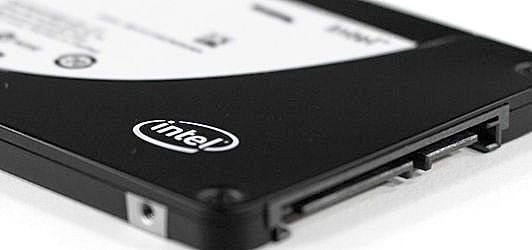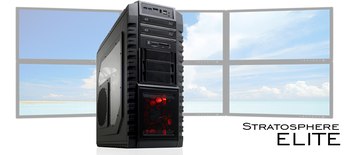Home >> Products >> Professional Workstations >> Tech Corner: Solid-State Drives (SSDs)

Tech Corner:
How Solid-State Drives (SSDs) Make Windows Multitasking Up to 25X Faster
With Intel X25 solid state drives (SSDs) in your Stratosphere computer workstation, you can unleash the full power of your fast Intel CPU and multi-screen monitor array, without being slowed down by a rotational hard drive … a relic from 1954!
Hard drives lag far beyond the speed of today's fast Intel quad-core processors, which causes fast computers to be much slower in "real world use" than they should be. These problems are especially apparent on fully loaded systems with multiple applications running on multiple monitors.
Windows virtual memory is the chokepoint
 |
Rotational hard drives throttle Windows performance by slowing down Windows virtual memory performance. Windows automatically moves background program files and data to your hard drive during multitasking, which optimizes available RAM at the expense of multitasking speed. With Windows virtual memory, more than half of your system's active memory can be on your hard drive!
On a fully loaded system, Windows virtual memory may generate hundreds of "page faults" per second: an event that can force Windows to fetch data from the hard drive instead of RAM. Each such memory fetch is about 40,000 times slower from the hard drive than from RAM!
If the number of requests exceeds the retrieval speed of the hard drive (as it will), guess what happens? Your application stops and waits! This is the #1 reason why your Windows computer slows down. This problem is not solved by a faster CPU!
Speeding up Windows virtual memory with SSDs
Adding more memory can help, but only to a point. Windows is designed to use virtual memory simply for resource efficiency, so that precious RAM does not fill up with unneeded garbage data.
Turning off virtual memory creates new problems, by wasting main memory for truly low-priority storage. The best solution is to avoid using a rotational hard drive altogether for the system drive, and use fast Intel solid-state drives (SSDs) instead. These SSDs store data in memory chips instead of a hard drive platter, enabling 25X - 100X faster I/O operations per second!
High reliability: keeping your data safe and your computer always bootable
 |
Unlike RAM, solid state drives use non-volatile memory chips (high-speed flash memory) that retain data after power is turned off. Unlike hard drives, Intel SSDs can't "crash," so they are actually safer than hard drives for long-term storage.
Digital Tigers also ships all SSD-class systems with an internal backup hard drive, which enables our customers to continue working in the event of failure to the system drive, whether that system drive is SSD or a rotational hard drive.
Intel SSDs are designed to withstand the intense read/write activity of Windows core operations, which makes them ideal as the primary system drive for your Stratosphere workstation. With the Windows operating system and your applications installed on Intel SSD, hard drives are reserved for what they do best: storing large files, such as media files.
Digital Tigers uses Intel X25 series SSDs because they are truly superior to other SSD products on the market today. SSD technology is not generic. We put the industry's best technology to work for you!
Watch the Intel video
Get Intel SSD with these workstations
 | |
| |
Learn more about Intel SSD
Awards for Intel SSD (among many)



Outstanding technical reviews
"Solid-state disk drives are suddenly everywhere, but many are not much faster than a HDD, some take just as much or more power, and most cost a fortune! Intel took the time to do an outstanding SATA interface on their X18-M, X25-M, and X25-E 1.8- and 2.5-in. SSDs.... We decided to give the Product of the Year Award to all three drives (you try to pick just one).
"The real trick here is they have a latency of 85 µs, which gets you 35,000 IOPS (I/O operations per second), 100 times more than a hard-disk drive. This is really good when you are reading lots of small files, which your computer does a lot."
—Electronic Products, January 2009"… you certainly get what you pay for with Intel’s new SSD… in many applications, it offers more than 2X the performance of any other MLC solid state disk that we’ve tested to date."
—Hot Hardware "Editor’s Choice Award", Sept. 8th, 2008"...the new X25-M; the name sounds very much like an experimental hypersonic plane. And the analogy isn’t far off, since the new flash SSD provides excellent performance... Intel did an amazing job..."
—Tom's Hardware", Sept. 8th, 2008"Within 6 months I'd expect it to be just as important to have one of these [Intel X25] drives in your system, as your boot / application drive, as it was to have Conroe [Intel Core 2 Duo CPU] in your system back in 2006.... This is bigger than Nehalem [Intel's latest CPU architecture for Core i7 processor and Xeon 5500].
"What Intel did with the X25-M is show the world what is possible with MLC flash.... Intel didn't start the SSD revolution but it sure did kick it into high gear."
—Anandtech, Sept. 8, 2008